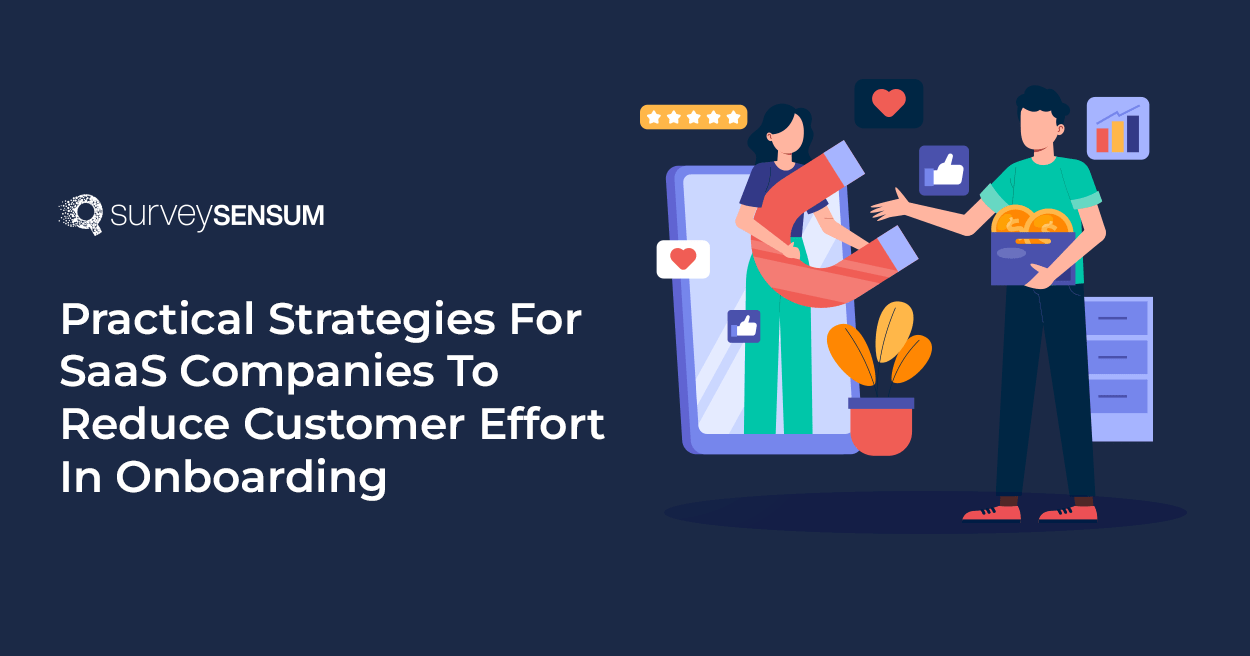
According to the book Product-Led Onboarding: How to Turn Users Into Lifelong Customers, 40-60% of new users won’t even bother to come back after they sign up.
Have you ever found yourself stuck in a seemingly endless loop of tutorials, forms, and confusing interfaces when trying out new software?
It’s an experience that can quickly turn excitement into exasperation.
But what if there was a way for SaaS companies to make onboarding a breeze, ensuring that every customer’s journey begins with a smile?
One of the key metrics used to gauge the effectiveness of onboarding is the Customer Effort Score (CES). This metric measures the amount of effort your customers have to put forth while onboarding and using your product or service.
In this blog, we’re taking a closer look at the concept of ‘Reducing Customer Effort in Onboarding’ and its significant impact on the user experience.
We’ll be delving into a variety of practical strategies that SaaS companies can employ to simplify the onboarding process and enhance customer satisfaction.
6 Proven Strategies to Reduce Customer Effort and Enhance Customer Onboarding
- Is It Easy To Sign-Up With You?
- Guide Your Customers Through Their Onboarding Journey
- Empower Your Customers To Solve Issues By Themselves
- Train Your Customer Support Staff To Be Proactive
- Assign Dedicated Onboarding Support Agents
- Gather Customer Feedback and Make Iterative Improvements
Simplify Onboarding for Customer Success: Focus on a Value-Based Approach
6 Proven Strategies to Reduce Customer Effort and Enhance Customer Onboarding
1. Is It Easy To Sign-Up With You?
Let’s say you got to know about a new email marketing software. What’s the first thing you will do to explore this software?
You will obviously search for the software, click on their website, read a little bit about them, and if everything looks good, you sign up. This is a standard way to explore the features and benefits of a SaaS product. By understanding the vital role of signing order, your product stands poised to capture and retain the attention it deserves. The journey from first interaction to successful conversion is mapped by each step—so craft your sequence with care, make each interaction count, and watch the path to customer satisfaction illuminate
But what if you encounter issues while signing up, the most basic step? Do you think you will feel confident about this platform anymore?
Probably not!
The more effort your customer have to put in order to do even a simple task such as signing up, the less likely they will become your customer. That is why it is important to make your sign-up process quick, easy, and hassle-free.
Take SurveySensum for example. It has a super easy signup process. You can create a new account by entering exactly three pieces of information – your work email, name, and a strong password. And that’s it, your account is created in less than 5 minutes! You are ready to launch a survey!
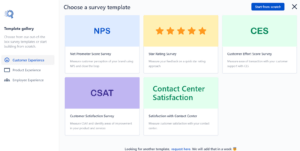
Just like SurveySensum, here’s how you can improve and create a smooth sign-up process for your SaaS company:
- Simplify Website Navigation and Information: A user-friendly website with detailed and comprehensible product information makes it easy for potential customers to learn about your SaaS product’s features and benefits.
- Optimize CTAs and Signup Process: Minimize friction by ensuring clear and concise calls-to-action that lead to a seamless signup process, reducing any unnecessary hurdles.
- Introduce Interactive Demos: Providing free and interactive demos before sign-up helps users understand the value proposition of your SaaS offering.
2. Guide Your Customers Through Their Onboarding Journey
When you guide your customers through the onboarding process, you’re essentially showing them the ropes to navigate your SaaS platform effectively. This initial guidance helps them get acquainted with your product’s features, functionalities, and benefits. By ensuring they have a clear understanding and a smooth start, you’re setting the stage for a satisfying experience.
A good, informative, and interactive demo video can help a lot in reducing customer effort during this critical phase – especially for first-time users.
According to a survey conducted by Wyzowl on video marketing, 69% of customers believe that a product demo best assists them when making a purchase decision.
In order to create an informative demo video, here are some tips you can consider:
Getting Started Videos:
Headspace introduces itself and guides its first-time users on how to sign up, use their products, and all the different features efficiently with its getting started video.
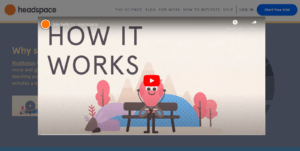
Feature Videos:
When you launch a new product or a new feature to your existing product it is best to create an introduction video that showcases all the features and benefits so that customers are well informed about them.
For example, Apple is known for creating eye-catching videos before the launch of its new product – highlighting the product’s new features and improvements.

3. Empower Your Customers To Solve Issues By Themselves
According to the Harvard Business Review article, Kick-Ass Customer Service, 81% of customers stated that they intend to take care of matters by themselves before reaching out to a customer service representative.
It is evident that modern-day shoppers are self-sufficient in resolving issues on their own. They know how and where to find help and solve issues or explore new products on their own. But sometimes they might get stuck and if proper help is not available at this point they might feel frustrated and leave.
This is the stage where you can intervene and provide help in the form of AI chatbots, FAQ pages, etc. With these tools, your customers can find help with navigation help, understanding particular features, and solving their issues or answering their own queries by themselves.
For example, Zendesk’s AI chatbot can be found on all its pages. Users can ask questions directly to the chatbot without needing to contact the sales team.
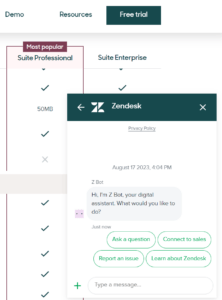
4. Train Your Customer Support Staff To Be Proactive
Let’s say you recently started using a new SaaS customer feedback software to create surveys and track feedback. You came across some issues while sharing your surveys via multiple channels so you contacted the customer support team for solutions.
They instantly solved the issue gave you tips on how to avoid the issue in the future and provided some learning videos on different features of the platform. These videos turned out to be helpful down the line when you encountered another issue but this time you didn’t have to call an agent, you got the explainer videos to learn from!
You see how the agent was proactive in anticipating your needs and providing solutions even before you needed them. Because of this proactive approach, you were able to save time and solve the issue on your own – making it an experience a hassle-free experience.
To achieve proactiveness in your customer support,
- Clearly define what proactive support means, its importance, and how it aligns with the company’s values and goals.
- Train your support staff to actively listen and understand customer needs. Encourage them to ask open-ended questions to gather more information about the customer’s situation, preferences, and pain points.
- Ensure that your team has a deep understanding of your products or services. The more they know, the better they can provide solutions to customers.
- Leverage your CRM system and other data sources to gain insights into customer behavior, preferences, and past interactions.
- Create templates and scripts for common scenarios that require proactive communication.
Improve Customer Onboarding with SurveySensum – Request a Demo
5. Assign Dedicated Onboarding Support Agents
We talked a lot about the importance of incorporating AI-driven chatbots and assistants into your website but can it replace human interaction?
No.
AI chatbots or assistants are there to assist you in managing automated tasks like navigation help, refund issues, etc. – something that can be resolved without agent involvement. But when it comes to helping first-time users in the onboarding process, it is best to assign dedicated support agents.
This is crucial because when a new user explores your product for the first time they might have doubts or questions and chatbots can be helpful till one point. Assigning dedicated agents here will ensure that your customers get personalized assistance and get their queries and concerns addressed personally.
Also, the agent’s expertise in onboarding ensures that users receive the attention and guidance they need, fostering a sense of support and empowerment. This personalized touch reduces customer effort by providing a direct line of communication for any onboarding-related questions.
6. Gather Customer Feedback and Make Iterative Improvements

The journey of reducing customer effort in onboarding is not a one-time thing. It is a continuous process and customer feedback plays an important part in it.
To achieve this,
- Incorporate in-app surveys that gather direct feedback from users regarding their onboarding experiences.
- Analyze the gathered feedback to identify recurring issues, challenges, and areas causing customer frustration or confusion.
- Prioritize the identified pain points based on their impact on customer experience. Focus on areas that contribute significantly to customer effort.
- Brainstorm and develop actionable solutions to address the prioritized pain points.
- Implement the proposed improvements in the onboarding process. These changes could involve simplifying steps, providing clearer instructions, etc.
- Track key metrics such as completion rates, time taken to onboard, and customer satisfaction scores to measure the impact of the implemented changes.
- Close the feedback loop by communicating the changes made to customers. Highlight how their feedback has driven positive changes and how the new onboarding process benefits them.
- Maintain an ongoing feedback loop with customers. Regularly seek their input to identify new pain points or to validate the effectiveness of recent improvements.
These are the 6 strategies that you can use for the SaaS customer journey to reduce customer effort in onboarding. Now, let’s talk about how to keep the entire process short and the importance of value-based customer onboarding focusing on effective strategies for SaaS.
Simplify Onboarding for Customer Success: Focus on a Value-Based Approach
Keep the Onboarding Short and Simple
Nowadays customers have so many options right at their fingertips. And let’s face it, the attention span isn’t what it used to be. Everyone wants things fast, and they want them now. That’s why businesses have to step up and adapt.
If you drag out the onboarding process, it’s a recipe for disaster.
Your customers get frustrated, some might give up and walk away which means a loss of revenue. But here’s the thing – by keeping that onboarding process short and sweet, businesses can actually make a great first impression.
But how to do that?
Understand Your Customers’ Goals
By understanding your customer’s goals and what success means to them. In order to make your customer’s onboarding experience a success you need to first understand what success means to them.
For example, your definition of success might be customers using your products or services for X times but that might not be what your customers are thinking.
Ask your customers directly to understand their goals and objectives during the onboarding process. This will also help you to keep the entire process direct, short, and personalized for your customers.
Take the example of Duolingo. When you sign up on Duolingo, it asks a few questions such as what language you want to learn, why you want to learn it, etc. These questions allow Duolingo to create a personalized experience for you that will ensure that you achieve your goals.
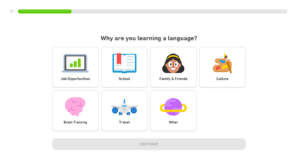
In the spirit of keeping things short and simple, let’s understand what is value-based onboarding.
Stick to Value-Based Onboarding
Imagine you’re welcoming someone into your world – a world filled with your amazing SaaS product. Now, you could overwhelm this new person by showing off every single feature and button available OR you can remind yourself that they’re here for a reason. They have specific goals in mind, things they want to achieve with your product. That’s where value-based onboarding comes in.
Value-based onboarding is about figuring out what your customers want to do with your SaaS product and teaching them only the things they aim to achieve with your product – instead of showing them everything you got, that’s not even relevant to their goals. This approach simply focuses on what’s most important for your customer’s goals.
By focusing on delivering immediate value and addressing users’ specific needs, value-based onboarding not only streamlines the onboarding process but also enhances customer satisfaction.
Wrapping Up
A frictionless onboarding experience not only leads to higher customer satisfaction rates, but also cultivates brand loyalty, increases customer lifetime value, and promotes positive word-of-mouth referrals. It also communicates the company’s commitment to the customer’s well-being and forms a solid foundation for the entire customer relationship.
To successfully reduce customer effort in onboarding, you should leverage the power of customer feedback. Gathering feedback through CES surveys just after customers complete their onboarding process ensures that your customers feel valued and provide accurate data. These insights can be analyzed to identify areas of improvement.
But don’t forget, reducing customer effort is not a one-time endeavor, it requires a continuous gathering of feedback and iterative improvements over time. And an efficient customer feedback platform like SurveySensum can be of great help. It not only makes it easier to create CES surveys with its in-built templates, you can gather real-time feedback and take action on it in time.






